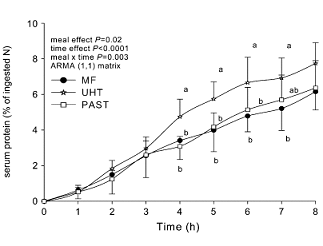|
Definition: "An ergogenic aid is any substance or phenomenon that enhances performance "
|
|
||||||||
30.11.2008 |
|
|
Protein in sterilised milk is a little faster
The proteins in sterilised long-life milk are just as good as those in pasteurised fresh milk. They are faster, which means the body converts them into protein more quickly. But on the other hand, the body breaks them down more quickly into urea, researchers at the INRA institute in France discovered.
So which is healthier? Long-life or fresh milk? Fresh milk, say the Dutch. The heat treatment that factories use to sterilise milk breaks down the proteins, making them less useful to the body. In France the thinking is different, and most consumers drink long-life milk. To find out whether there was any truth in the Dutch point of view the researchers did an experiment with thirty volunteers. They all had to drink half a litre of milk. One group was given pasteurised milk, the second group got microfiltered milk and the third group drank sterilised milk.
The nitrogen atoms in the milk proteins were labelled so that the researchers could track them. When the researchers measured the concentration of amino acids in the blood of the test subjects they couldn’t see any difference. But when they looked at what the body did with the milk proteins a difference did show up.

The graph shows how much protein from the milk is absorbed over time by proteins in the body. The proteins from the long-life milk are absorbed faster and in greater quantities. The heat treatment seems to have loosened the connections between the protein fragments so the digestive system can break them up more easily and as a result the amino acids and protein fragments enter the human system more quickly.
But this also means that the body breaks down the proteins from long-life milk more quickly. The chart below shows the amount of the labelled nitrogen atoms the researchers traced in the test subjects' urine.
As the table shows, there was no effect.
Milk proteins in sterilised milk are therefore slightly faster than the proteins in fresh [pasteurised] milk. They behave less like the slow proteins found in most protein-rich solid foods, and more like the fast proteins in whey or soya. Fast proteins cause higher peaks in protein metabolism than slow proteins do. The peaks raise the anabolic effect, but this is achieved at the cost of the efficiency with which the body builds itself up with protein. See the table below.
PPUN = the extent to which the body retains protein after a meal.
The differences are small, and only relevant for athletes who really want to get the maximum out of their diet. If you are such a dedicated sportsperson, and if you get at least 35 percent of your energy from proteins, it's probably worth your while to eat slow proteins, which force your body to be economical in its protein use.
Athletes with a lower protein consumption, and who also believe in the timing of protein intake, are better off using fast proteins which they eat one hour before and probably also after their training session. You will build more muscle mass by training in such a way that the training stimulus coincides with a protein peak.
Sources:
|
|



